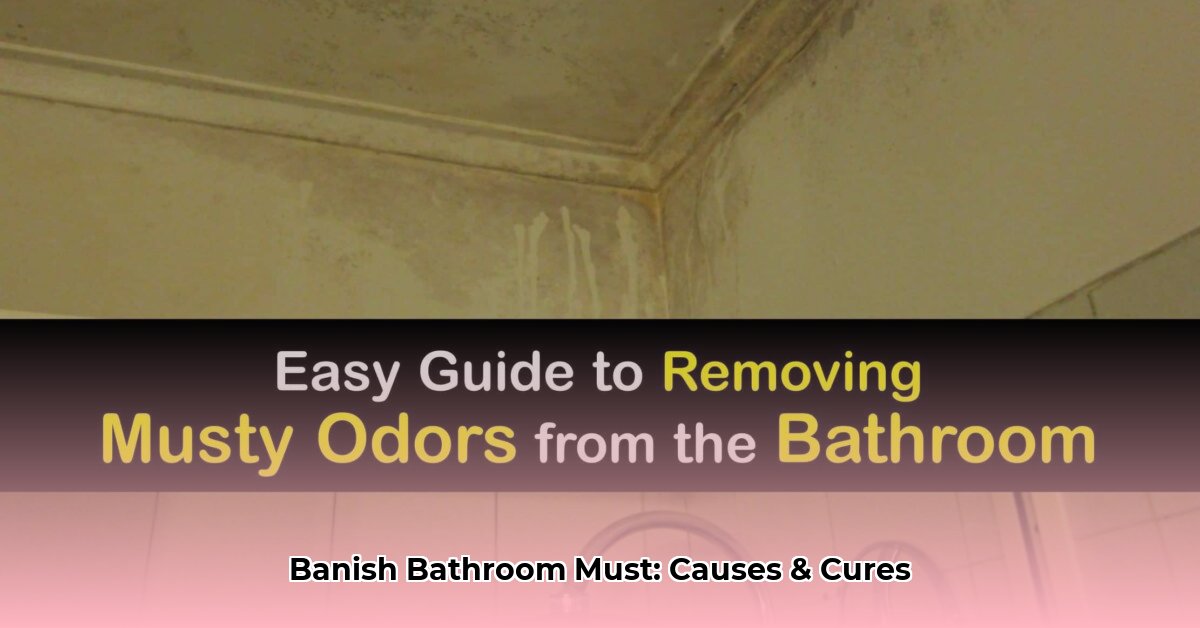That lingering musty smell in your bathroom? It’s more than just unpleasant; it’s often a sign of a moisture problem. But don’t worry, conquering that bathroom funk and achieving a consistently fresh, clean space is entirely doable. This guide will walk you through everything you need to know, from pinpointing the source of the mustiness to banishing it with simple solutions and preventing it from returning.
What’s Causing That Musty Smell?
That funky odor likely comes down to a few common culprits:
- Mold and Mildew: These microscopic fungi thrive in damp, warm environments, making your bathroom their ideal playground. Look for dark spots, discoloration, or a fuzzy texture on grout, walls, ceilings, shower curtains, and bath mats.
- Clogged Drains: Hair, soap scum, and other debris decompose in drains, creating a stagnant, smelly mess and a potential breeding ground for bacteria.
- Hard Water Deposits: Mineral buildup from hard water can harbor bacteria, contributing to mustiness.
- Damp Fabrics: Damp towels, bath mats, and even wet washcloths left lying around are mildew magnets.
- Hidden Leaks: Even tiny leaks under sinks or behind walls can create persistent dampness that fuels mold and mildew growth.
- Poor Ventilation: Inadequate ventilation traps moisture, creating a perfect environment for musty odors to develop.
Quick Fixes for a Fresher Bathroom
Need a fast solution? Try these quick fixes:
- Open a Window: Fresh air can quickly dissipate musty odors.
- Run the Exhaust Fan: Ventilate during and after showers to remove excess moisture. If your fan is weak, consider upgrading to a more powerful model, possibly one with a humidity sensor.
- Baking Soda Power: Sprinkle baking soda on musty surfaces, let it sit, then vacuum. Keeping an open box under the sink can provide ongoing odor absorption.
- Activated Charcoal: A bowl of activated charcoal can absorb both moisture and odors. Replace the charcoal periodically for optimal effectiveness.
- Natural Sprays: Dilute a few drops of tea tree oil or grapefruit seed extract in water and spray after cleaning for their antifungal properties and fresh scent.
Deep Cleaning for Lasting Freshness
Ready for a more thorough approach? These cleaning methods can eliminate the source of the mustiness:
- Vinegar Solution: Spray undiluted white vinegar on affected areas, let it sit for 30 minutes, then scrub and rinse. For stubborn mildew, add a few drops of tea tree oil or grapefruit seed extract to the vinegar.
- Baking Soda Paste: Make a paste of baking soda and water, apply to mildew or hard water deposits, let it dry, then scrub and rinse.
- Bleach Soak (for Fabrics): Soak musty towels and bath mats in a diluted bleach solution (follow product instructions), then wash thoroughly. Note: Bleach can damage some fabrics, so test in an inconspicuous area first.
- Drain Cleaning: Pour ½ cup baking soda down the drain, followed by 1 cup vinegar. Let it fizz for 30 minutes, then flush with hot water. For stubborn clogs, use a plumbing snake or plunger. (Use chemical drain cleaners sparingly, as they can damage pipes.)
- Commercial Cleaners: Use specialized mold and mildew cleaners for heavily affected areas, always following product instructions and ensuring good ventilation.
Preventing Mustiness: Long-Term Strategies
The best way to deal with mustiness is to prevent it. Here’s your prevention plan:
- Maximize Ventilation: Run the exhaust fan during and after showers. Open windows whenever possible. Consider a humidity-sensing fan.
- Dry Surfaces Thoroughly: Squeegee or wipe down shower walls and doors after each use. Hang towels and bath mats to dry completely, ensuring proper airflow.
- Regular Cleaning: Implement a weekly cleaning routine to prevent mold and mildew from taking hold.
- Address Leaks Immediately: Fix any leaks promptly, no matter how small. Even minor drips can contribute to moisture problems over time.
Troubleshooting Persistent Mustiness
If you’ve tried everything and the musty smell persists, investigate further:
- Hidden Mold: Check for hidden mold behind walls or under sinks. If you suspect a serious mold problem, especially black mold, consult a mold remediation professional.
- Plumbing Issues: A persistent musty smell, especially if accompanied by a sewage-like odor, could indicate a plumbing problem. Call a plumber to investigate.
- Dehumidifier: If your bathroom is chronically damp, consider using a dehumidifier to reduce moisture levels.
- Humidity Monitor: A humidity monitor can help you track moisture levels and identify potential problems before they lead to mustiness.
Helpful Products
- Dehumidifier: Reduces excess moisture.
- Humidity Monitor: Tracks moisture levels.
- White Vinegar: A natural cleaning powerhouse.
- Baking Soda: Absorbs odors and acts as a gentle abrasive.
- Tea Tree Oil & Grapefruit Seed Extract: Natural antifungals with fresh scents.
- Mold and Mildew Cleaners: For tackling tough growth.
A fresh, clean bathroom is attainable! Following these tips, you can banish mustiness and create a relaxing, enjoyable space. Remember, consistency is key. By addressing the causes and incorporating these preventative measures into your routine, you can maintain a fresh-smelling bathroom for the long haul.
- Achieve Consulting Work-Life Balance: A Practical Guide - December 7, 2025
- Achieve Anesthesiology Work-Life Balance: Your Guide - December 4, 2025
- Unlock Young Doctors’ Work-Life Balance: Actionable Strategies Now - December 2, 2025
















